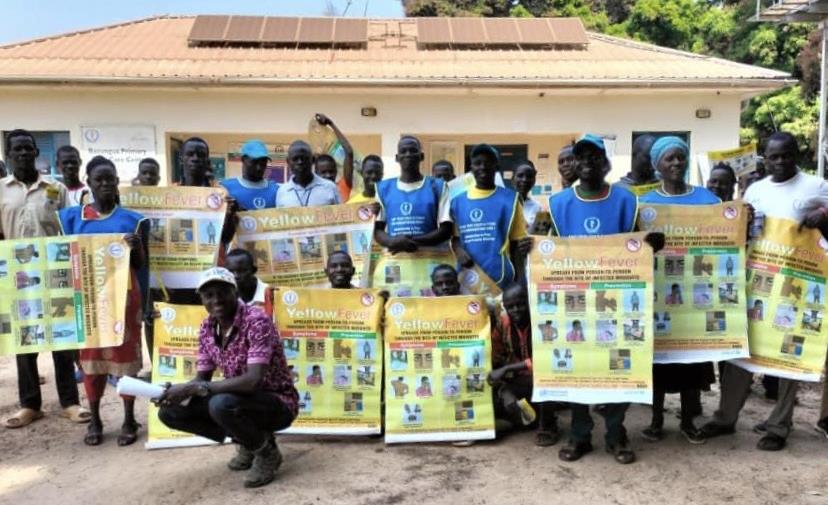
Health workers engaged in risk communication and community engagement activities during the 2023-2024 yellow fever outbreak in South Sudan’s Western Equatoria State. © Ministry of Health of South Sudan
The 7-1-7 target has proven to be a critically important tool for countries to assess the performance of their health systems, quickly identify bottlenecks to effective action, and move from capacity measurement to system improvement. In South Sudan, although the outbreak is still ongoing, instead of hundreds of cases expanding into a nationwide or even regional epidemic, 78 suspected and 3 confirmed cases concentrated in a single state in South Sudan have been identified as of late March, with 6 fatalities. By comparison, during the country’s last large yellow fever outbreak in 2003, there were a total 178 cases with 27 deaths in the same time period.
Under the 7-1-7 organizing principle, every suspected outbreak is identified within 7 days of emergence, reported to public health authorities with initiation of investigation and response efforts within 1 day, and effectively responded to – as defined by objective benchmarks in defined categories – within 7 days. This 7-1-7 target provides a global basis for accountability and has already been successfully applied by several countries to assess and improve their performance.
Because South Sudan is hit by frequent health emergencies, country leaders recognized the need to accelerate the time taken to detect, notify, and respond to emerging outbreaks to better contain disease spread and save lives. Encouraged by the early successes of Uganda and other African countries that have adopted the 7-1-7 target, South Sudan joined the 7-1-7 Alliance shortly after its formation in May 2023.
The 7-1-7 Alliance is a country-led initiative that provides technical assistance and financial support – as well as a growing global community of practice – to help all countries achieve the 7-1-7 target. In one of its first actions as an Alliance partner, South Sudan sent a delegation led by the country’s Director of Health Security and 7-1-7 technical lead Dr. Angelo Goup Thon Kouch to neighboring Uganda, marking the first peer-to-peer visit within the Alliance. Because the two countries had built strong relationships through the years, it was natural that they would collaborate on health security issues.
Providentially, the 7-1-7 team at South Sudan’s Ministry of Health had just finished training relevant country stakeholders in December just as the current yellow fever outbreak emerged. “The 7-1-7 Alliance is among the best modern global initiatives,” said Dr. Angelo. “Applying the 7-1-7 target and tools can quickly improve countries’ preparedness and response by helping identify bottlenecks and enablers, as well as facilitate root cause analysis for better decision making.”

Health workers engaged in risk communication and community engagement activities during the 2023-2024 yellow fever outbreak in South Sudan’s Western Equatoria State. © Ministry of Health of South Sudan
Dr. Angelo and his team applied their new understanding of the 7-1-7 target to assess the yellow fever outbreak in real time using the World Health Organization’s Early Action Review protocol, which leverages the 7-1-7 target by incorporating it into official WHO guidance.
Overall, South Sudan’s outbreak detection and response systems performed well, and the 7-1-7 target was achieved. “When you apply this approach correctly,” Dr. Angelo observed, “you can see positive progress in your response within very short time.” Several bottlenecks were identified, many of them organizational and structural issues. They were easily addressed once 7-1-7 findings were shared with a wide group of stakeholders including WHO and UNICEF.

Timeline of the yellow fever outbreak emergence, detection, notification and early response in South Sudan.
Most notably, there was a lack of yellow fever vaccines, which the Ministry of Health prioritized obtaining and received within three weeks. This allowed for full activation of the national rapid response team; more than 350,000 people in affected counties have already been vaccinated, and an additional 250,000 will be vaccinated as doses are allocated. The extensive vaccination of affected populations, coupled with messaging on yellow fever prevention, is a major reason why this outbreak has been so well contained compared with past outbreaks.
However, the outbreak is not over. Financial constraints and community misperceptions about the yellow fever outbreak have hindered the effectiveness of the response. There is an urgent need to mobilize more resources to enhance case management, lab sample management, and vector control.
Moving forward, South Sudan plans to further strengthen vaccination programs for populations at higher risk, improve health promotion and risk and crisis communications efforts, bolster community outreach and engagement, and establish permanent epidemiologic and case management training for health workers – all areas identified for improvement in the Early Action Review.
The Republic of South Sudan will continue applying 7-1-7 tools to new and previous outbreaks, cascade 7-1-7 training to subnational and community levels, and expand peer-to-peer learning opportunities among countries. Through this ongoing learning process from training and country experiences, South Sudan has benefited from collaboration with our neighbor Uganda and technical and financial support from the Alliance.
Dr. Angelo Goup Thon Kouch